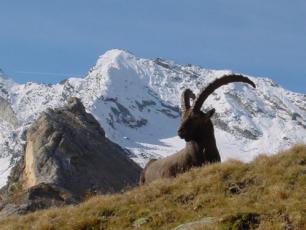
Lake Lozon – (Verrayes) A rapidly drying lake on a glacier terrace, in the heart of a dry region. Home to rich zooplankton with more than 30 species including numerous invertebrates such as the common toad and red frog, over one hundred marsh species of which some are rare and unique to the Aosta Valley.
Les Iles (Brissogne) Situated on the Dora Baltea river, the reserve has two quarry lakes and is an important regional stop over and feeding ground for migratory birds. Home to amphibians, reptiles and in the lakes; tenches and pikes.
Lale Lolair (Arvier) – Fed by three springs, the lake is home to a large planktonic population with numerous floating species, amphibians, reptiles.
Mont Mars – covers 300 hectares and located at the head of the Pacoulla stream valley where you’ll find evidence of glacier morphology,rock basins, small lake and marsh basins. Flora: arnica,purple gentian, nigritella; Fauna:grass frog, char, white-throated dipper, grasssnake, crow, chamois, hare, fox. The reserve is a golden eagle’s hunting ground!
Lake Villa – low mountain lake-marsh basin, covers 25 hectares at altitudes between 810 and 980. The main reproduction station in the Aosta Valley for the common toad, local reptiles. Home to two floating plants rare in Aosta Valley – white waterlily and the amphibian lily.
Holay Pond (Pont-Saint-Martin) – the natural reserve covers 1,5 hectares at an altitude of 750m-790m, near Suzey Castle. The only area in the Aosta Valley where you will find spatulaleaf loosestrife. Includes some rare amphibian species.
Marais (La Salle) – Located near the dam along the Dora Baltea river between the towns of La Salle and Morgex. A stopover for wetland migratory birds. Wild ducks, gallinules, reed warblers nest here.
Tsatelet The reserve extends across 14 hectares at an altitude of 720-796m. An excellent area for birdwatching especially during migratory periods. Home to some mammals, reptiles and various invertebrate species. A Neolithic settlement dating back 3,000BC was situated at the top of the hill. Home to some mammals, reptiles and various invertebrate species. A Neolithic settlement dating back 3,000BC was situated at the top of the hill.
Parc Animalier d'Introd (Animal Park) - a park where you can observe, discover and understand providing a nature lesson for young and old alike. Located in Introd not far from Courmayeur. Open everyday from from 09:30am till 18:00.
For more information


 4.9 nodi km/h SW
4.9 nodi km/h SW